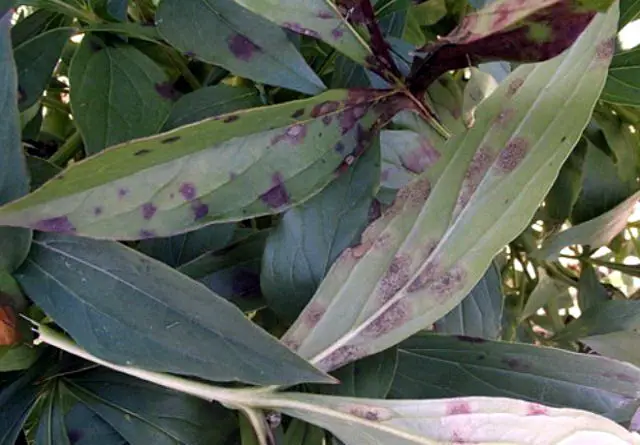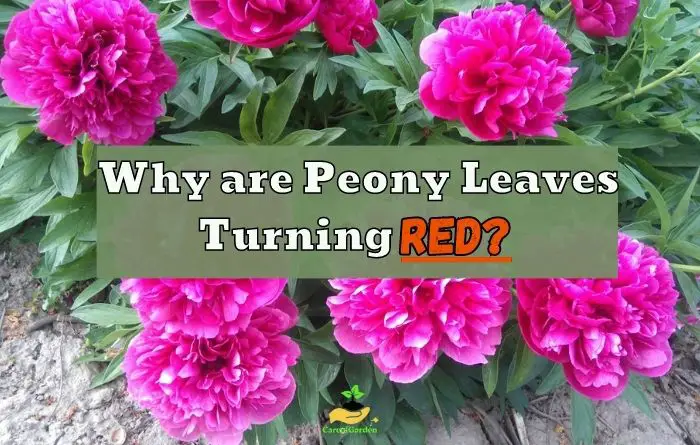Peony Leaves Turning Red? (4 Surprising Reasons)
Are you seeing peony leaves turning red in your garden? Don’t worry; you’re not alone! Peonies are quite susceptible to changes in soil and lighting that cause their leaves to turn red. In this article, we’ll dive deeper into the factors that contribute to the reddening of the leaves and how you can fix it.
Peony leaves are turning red due to nutrient deficiency, pH imbalance, diseases such as peony leaf blotch , or excessive sunlight. To restore their natural green color, maintain a balanced pH level, ensure proper fertilization, implement disease prevention measures, and provide adequate shade. Planting peonies in well-draining soil with good organic matter can also enhance their overall vitality and leaf pigmentation.
| Peony Leaves Turning Red |
|---|
| 1. Nutrient deficiency |
| 2. Change in soil pH |
| 3. Excessive sunlight |
| 4. Diseases |
1. Nutrient deficiency

Peony is a very demanding plant and requires certain nutrients to maintain healthy foliage. This is why a nutrient deficiency such as phosphorus, potassium, or trace elements (iron, manganese) will cause the peony leaves to turn red.
| Nutrient | Function | Deficiency Symptoms | Possible Causes |
|---|---|---|---|
| Phosphorus | Energy transfer, root development | Red or purplish leaves starting at the tips and progressing towards the base | Low soil fertility, pH imbalances |
| Potassium | Water regulation, nutrient transport | Red or bronze leaves starting at the margins and progressing inward | Poor soil quality, inadequate fertilization |
| Iron | Chlorophyll production, photosynthesis | Yellowish or interveinal chlorosis (yellowing between veins), sometimes appearing reddish | Alkaline soil conditions, poor iron availability |
| Other nutrients (e.g., magnesium, calcium, manganese) | Various physiological processes | Leaf reddening and other symptoms of nutrient imbalances | Soil imbalances, inadequate nutrient uptake |
A lack of phosphorous in peonies will inhibit their ability to produce sufficient chlorophyll, the green pigment responsible for photosynthesis. As a result, the leaves start getting a red or purple discoloration. The reddening of leaves is often more pronounced in the veins or along the leaf edges.
Phosphorous is a vital nutrient for plant development and plays a crucial role in various physiological processes, including energy transfer, root development, and photosynthesis.
A phosphorous deficiency in the soil is caused by factors such as poor soil quality, improper fertilization, or excessive leaching of phosphorous from the soil.
Also, soils with a high pH level or excessive calcium can hinder the availability of phosphorous in your peonies.
Treatment
To treat phosphorous deficiency and prevent red leaves in peonies, it is important to ensure that the soil has an adequate supply of this nutrient.
Adding phosphorous-rich fertilizers or organic amendments, such as bone meal or rock phosphate, can help replenish phosphorous levels in the soil. It is advisable to follow the instructions on the fertilizer label and apply the recommended amounts to avoid overfertilization.
Also, you can apply phosphorus-potassium fertilizers or wood ash, which you sprinkle on the ground during loosening and mix with the main soil or ordinary top dressing in the form of fertilizer or compost.
After top dressing, peonies must be watered, moisture with nutrients will fill areas lacking minerals.
2. Change in Soil pH
Peonies are particularly sensitive to soil pH, which directly affects nutrient availability and uptake, and an imbalance in pH will result in peony leaves turning red.
Peonies prefer a slightly acidic soil pH between 6.0 and 7.03. A pH level of 7.0 or higher is considered too alkaline for peonies, and can result in less available iron in the soil. This iron deficiency can cause chlorosis or yellowing of the leaves, followed by the reddish discoloration of the leaf margins.
Treatment
To avoid pH-induced red leaves in peonies, you should check the pH level of their soil frequently and ensure they maintain the correct balance.
If your soil pH is too high, adding soil amendments like sulfur or ferrous sulfate to reduce the pH will help you fix this issue. On the other hand, if your soil pH is too low, try adding lime to increase it’s pH.
You can improve pH balance by adding organic matter, such as compost or well-rotted manure, to the soil. Organic matter acts as a buffer, helping to stabilize pH levels and enhance the soil’s overall fertility.
3. Excessive Sunlight
Excessive sun exposure will cause peony leaves to turn red. When peony plants receive too much direct sunlight, it will cause stress and lead to photoinhibition, a process where excessive light damages the chlorophyll pigments responsible for photosynthesis.
This damage can disrupt the normal production and function of chlorophyll, resulting in the breakdown of chlorophyll molecules and the accumulation of other pigments, such as anthocyanins.
Anthocyanins are natural pigments responsible for the red, purple, or blue colors in many plants, including peonies.
When peonies are exposed to excessive sunlight, they may produce higher levels of anthocyanin pigments as a protective response to shield the leaves from further damage caused by ultraviolet (UV) rays. This increased production of anthocyanins can give the leaves a reddish or purplish appearance.
Treatment
Try to give your peonies some shade during the hottest part of the day. To do this, place a shade cloth above them or if you can, move them to areas with filtered sunlight, such as under trees.
When planting peonies, choose a location that offers some protection from excessive sunlight. Partial shade or dappled sunlight conditions are often ideal for peonies to thrive.
4. Diseases
Several fungal diseases can affect peonies, leading to leaf discoloration and the development of red or reddish-purple spots or lesions on the peony leaves. One common fungus disease is peony leaf blotch (caused by the fungus Cladosporium paeoniae).
Peony Leaf Blotch (Cladosporium paeoniae)

Peony leaf blotch is a fungal disease that commonly affects peonies, causing red discoloration on the leaves. This disease causes irregularly shaped spots or blotches on the leaves, often with a reddish or purplish coloration.
As the infection progresses, the spots may enlarge and merge, resulting in extensive reddish discoloration.
These fungal diseases typically affect the leaves by causing damage to the cells and disrupting normal physiological processes.
The presence of the fungus interferes with the plant’s ability to carry out photosynthesis effectively and can lead to the accumulation of pigments like anthocyanins. Anthocyanins are responsible for the red, brown, or black coloration seen in infected peony leaves.
| Symptoms of Leaf Spot | Preventive Methods |
|---|---|
| Small reddish-brown spots on the leaves | Improve air circulation by proper plant spacing |
| Spots grow larger and turn dark red or purple over time | Avoid overhead watering and wetting of foliage |
| Infected leaves may eventually drop off | Remove infected leaves promptly |
| Dark purple or black spots may appear on stems and flowers | Provide adequate spacing between peonies to promote air circulation and reduce humidity |
| Severe infections can lead to defoliation and overall weakening of the peonies. | Ensure optimal plant nutrition and soil health to strengthen your peony resistance |
Treatment
Prune and remove infected plant parts, ensuring proper disposal to prevent disease spread.
Apply fungicides specifically formulated for peony leaf blotch, following the manufacturer’s instructions. Consider copper-based fungicides or those containing mancozeb as potential treatments.
Gray Mold (Botrytis blight)
Bacterial diseases can also impact peony foliage and result in red discoloration. For example, bacterial blight (caused by the bacterium Pseudomonas syringae pv. paeoniae) can cause reddish or brownish streaks or lesions on your peonies leaves.
The affected areas may show a reddish halo around the lesions, contributing to the overall reddening of the leaves.
| Symptoms of Botrytis Blight | Preventive Methods |
|---|---|
| Dark red or purple spots on the leaves | Proper plant spacing and air circulation |
| Fuzzy grayish or brownish mold on the spots | Avoid overhead watering or excessive irrigation, as moist conditions favor the development and spread of Botrytis blight. |
| Reddening of the foliage of the flower appeared suddenlу and intenselу. | Remove infected plant debris promptly |
| Distorted or wilted leaves | Maintain optimal soil fertility and provide balanced nutrition to keep peonies healthy and better equipped to resist diseases. |
Treatment
If your peonies are already affected by Botrytis blight, there are treatment options available. The first step is to start pruning and destroying any of your peonies infected leaves and practice proper sanitation measures to minimize the spread of the fungus.
Fungicides containing active ingredients like thiophanate-methyl or iprodione are commonly used for controlling Botrytis blight and can also be used as recommended by experts. It’s important to follow the instructions on the fungicide label carefully.
Some beneficial microorganisms, such as Bacillus subtilis or Trichoderma species, can help suppress the growth of the Botrytis fungus. These can be applied as foliar sprays or incorporated into the soil as a preventive measure.
Frequently Asked Questions
Yes, peony leaves can turn red in the fall. This is a natural process that occurs as the seasons change. This change in leaf color adds to the stately and dignified appearance of the peony plant as it prepares for the colder months ahead.
Yes, certain fungal diseases like botrytis blight or leaf spot can cause peony leaves to turn red prematurely. It is important to inspect the plant for signs of disease and address any issues promptly to prevent further damage.
Yes, environmental factors like temperature and light intensity can impact the intensity and timing of peony leaf color change. Cooler temperatures and shorter daylight hours can accelerate the process.




